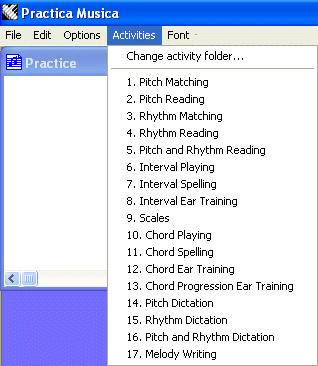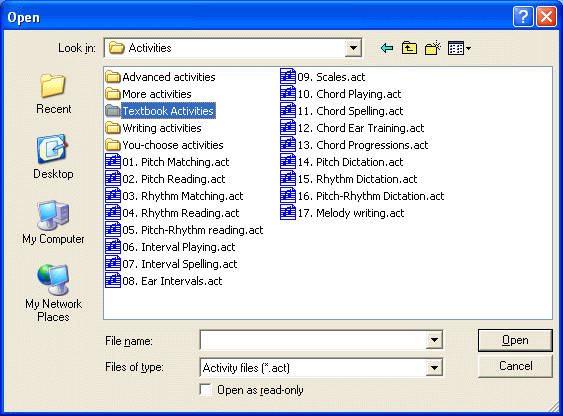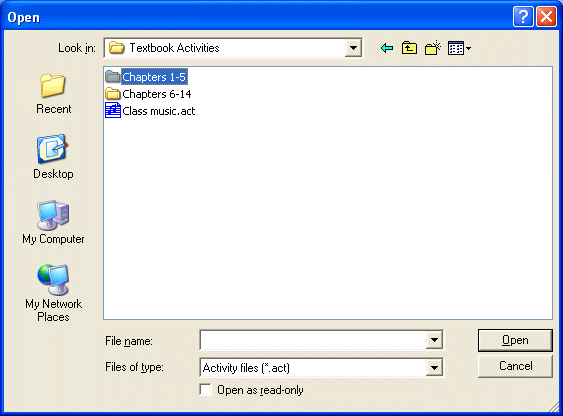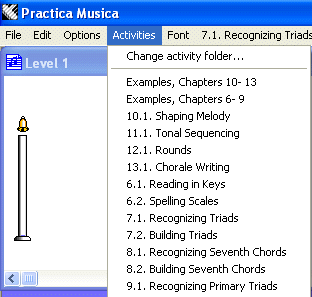Study Guide
Week 2
[ Reading ] [ Textbook ] [ New Material ] [ What You Should Know ] [ Homework ]
Textbook
Reading: pp. 52 - 61 in the textbook. Always review the summary information at the end of each chapter.
Turn in worksheets 3, 4, 5, 7, 8, 9, 10, 13, 14, 19, 25, and 26 from the back of the textbook. Write in the chord symbols above the triads on worksheet 26.
Do the following exercises using the Practica Musica software from the textbook. When you're done, print out a copy of your progress report to turn in showing your name and scores. If you use a computer in the department piano lab you can use the piano keyboard for input to the program instead of the mouse.
Exercise Page in textbook Activity 1.4 5 reading pitches on treble clef 1.5 5 reading pitches on bass clef 1.6 9 accidentals 3.1 23 rhythm 3.2 26 rhythm dictation 4.1 29 syncopation 5.1 34 identifying intervals 5.2 35 speed identification 5.3 38 building intervals 7.1 53 recognizing triads (book says "building triads" by mistake) To access these exercises you need to change the activity folder. The examples below are how the screen looks when running the software on a PC. The Mac version is similar.
Review
Remember how a major scale is constructed. It is a series of notes that fills in an octave. You can think of it in two ways:
- Start on any note, then go up the regular series of intervals: whole, whole, half, whole, whole, whole, half
- Write the ovals on lines and spaces between the starting and ending note and then fill in the appropriate accidentals based on your knowledge of the key signatures and Circle of Fifths.
New Material
Intervals
A musical interval is the distance between two keys. To form an interval, construct a major scale above the bottom note, in the example below, the note "D":
A major second (M2), or whole step, is the distance from the first note of the scale ("D") to the second note ("E").
A major third (M3) is the distance from the first note of the scale ("D") to the third note ("F#").
Seconds, thirds, and sixths formed this way (from the root/first note of the scale up to the Nth note) are major.
For acoustical reasons dating back to the ancient Greeks there is another category of intervals formed between the first and Nth note of the major scale. Two notes of the same pitch played together are are "Perfect Unison" or "unison". Two notes of the same pitch class played eight notes apart are a "Perfect Octave" or "octave. Fourths and Fifths are also "perfect", not "major".
If you lower the top note of a M2 by a half step the interval becomes a minor second (m2). Lowering a major third (M3) by a half step the interval becomes a minor third (m3). Lowering the top note in a M6 by a half step turns the interval into a m6. A M7 reduced by a half step becomes a m7.
The "perfect" intervals are treated a little differently. There is no such thing as a "minor fifth". Lowering the top note of a perfect fifth (P5) by a half step turns it into a "diminished fifth" (d5). We don't think of lowered P4's as d4's because they sound like major thirds.
It is easier to construct intervals above a given pitch. Just create a major scale starting on the lower note and go up to the necessary Nth note to find the upper note, and lower it a half step if it is not to be a major interval.
Finding the bottom note for a given top note and interval is a little trickier. For example, if you are given note X and asked to locate the note a M6 below, ask yourself: "What major scale has note X as its sixth note?" The root of that scale is the note you are looking for.
Minor and diminished intervals are a half-step smaller than major and perfect ones. For example, to find a major (2nd, 3rd, or 6th) or perfect interval (4th, 5th, or octave) above the note "D", first construct a D major scale:
A major sixth (M6) can be constructed by taking the first note of the major scale and combining it with the 6th note of the major scale. In the case of a M6 above "D", you would then choose the note "A"
A minor 6th (m6) is a half step smaller than a M6. If the bottom note is fixed you then lower the top note by a half step.
What we have done so far is to find intervals above a fixed note, using the major scale of the lower note. It is a bit trickier if you are trying to find an interval below a note instead. For example, if you want to find a M6 below the note "F#", then you have to ask "'F#' is the 6th note of what major scale?". Start by placing ovals on the lines and spaces starting with F# as the 6th note and working your way down to 1st:
We know that the oval note head will go on "A". The question now is, "Is F# the sixth note of the Ab major scale, the A major scale, or the A sharp scale?". Whichever scale has F# as the 6th note will be the note we are looking for: Ab, A, or A#. Ab major.
An Ab major scale has F natural as its 6th note.
An A major scale has F# as the sixth note. Yeah! We found it!
We could have eliminated A# as an option--it's not on our Circle of Fifths.
So now we know that the note a M6 below "F#" is "A", because "F#" is the sixth note of the A major scale. To find the note a minor sixth below, we have to decrease the size of the interval by a half step. If our top note "F#" is fixed, we'll have to raise the bottom note by a half step:
Triads in major keys
Like major scales, there are a couple of different ways to think about how chords are constructed.
In the first system here, the degrees of the scale and their alterations are used to make "recipes" you can memorize.
quality
major
minor
augmented
diminished
suspended
example
chord
symbolC
Cm
C+
Co
Csus
degrees
5
5
5
+5
-5
5
3
3
-3
3
-3
4
1
1
1
1
1
1
Starting with the major triad, you can take the 1st, 3rd, and 5th notes of the major scale and stack them on top of each other, so the recipe is "1,3,5". To make a minor triad, you take the 1st, 3rd lowered a half step, and 5th of the major scale, so the formula is "1,-3,5". For augmented you take the 1st, 3rd raised a half step, and 5th raised a half step, or "1,+3,+5", etc. I suggest that you use the "-" sign for lowering and the "+" sign for raising.
Many people use "b" and "#" sings instead of "-" and "+" since these are the musical signs normally used for lowering and raising notes. The problem with that system is that to go from a major to a minor chord you always lower the third degree, but this is not always done by flatting the third.
To go from C major (C-E-G) to C minor (C-Eb-G) you do flat the third (see below), but in most of the sharp keys (those key signatures on the right side of the Circle of Fifths) for example, lower the third degree is done by taking away the sharp on the third degree instead of flatting it. For example, D major (D-F#-A) moves to D minor (D-F-A) by lowering, but not flatting the third.
to go from C to Cm you lower (flat) the third
to go from D to Dm you lower (take away the sharp) the third
The other, more traditional way to think about chord construction is based on intervals:
Major Minor Augmented Diminished Sus top m3 M3 M3 m3 M2 bottom M3 m3 M3 m3 P4
To construct a major chord with this system you create a major third (M3) above the root, and then a minor third (m3) between the top two notes:
A minor chord is then a m3 on the bottom and a M3 on top:
Diminished is formed with two m3's:
Augmented is two m3's:
The last triad for us is the sus chord, with a fourth (P4) on the bottom and a major second on the top (M2):
To put them into the context of our study of the function of chords within a key, you find all but the augmented and sus triads in the "chord scale". Stacking up thirds above each note in the scale, the chords built on I, IV, and are always major (indicated with uppercase Roman numerals), ii, iii, and vi are always minor (lower case Roman numeral), and vii is always diminished (lowercase "vii" with a "°").
The qualities of the chords built on the successive notes of the major scale are always the same in any key:
major minor diminished I, IV, V ii, iii, vi vii°
It's time to go find a keyboard to experiment with.
Looking at this on paper doesn't get you very far. The best way to integrate the information is to go to a keyboard and play the chords, keeping your hand in a thumb-middle-little finger hand position, and then move your thumb up note by note playing the notes of whatever scale/key you are in. The middle and little fingers move along to the right each time in parallel with the thumb. Do the exercise in C major, saying the names and functions of the chords as you go: "I - C major, ii - D minor, iii - E minor", etc.
Then do the same thing, this time in G major. First play the notes of the G major scale one by one, and then add the triads, saying: "I - G major, ii - A minor, iii - B minor..." This should feel and sound a lot like it did as when you were in C major, except that this time you've got to watch out and replace all the "F" notes with "F#"s. Some light bulbs should light up in your brain as you do this, and some "Ah ha!"s escape your beaming face once you catch on to what's going on. The meaning of the key signature "G major" with one sharp will have some concrete expression.
Once you've got that, do the same thing with D major, now keeping the sharp you already had (F#) and adding a new one, C#. Say aloud "I - D major, ii - E minor, iii - F# minor..."
Why do you have to say things out loud? Well, of course, you don't have to. It is definitely harder since you have to think of more things, but then that's the point. What you're trying to do is to integrate a number of things: the notation on the page, the way it feels with your fingers, where the notes are located on the piano, how they sound, the functions (Roman numerals), and finally the chord names. Saying the words moves your articulators and moving those muscles helps you remember it better, meanwhile you're hearing the information and that goes in another sense. Writing out the exercise in the different keys on paper and looking at it as you go will help hook up the visual sense. The icing on the exercise is to sing the information "I - C major, ii - D minor..." on the root of each chord--sing a "C" note while you're on the I chord, a "D" when you change to the ii chord, and so on.
You can keep going around the Circle of Fifths with this exercise adding sharps as you go (in the order Fat Cats Go Down Aleys Eating Birds) and starting over with the flats going around the Circle counterclockwise adding flats (B-E-A-D Greatest Common Factor). Do a few keys a day and within a week you'll be able to do it in any key.
Test your ability to recognize triads of various qualities.
Triads in Minor Keys
The triads in minor keys have a different sequence and have more variation. We will come back to those later in the course. At this point you should be aware of the natural, melodic, and harmonic minor scales.What You Should Know
At the end of this week you should be able to:
identify and construct intervals between pairs of notes
be able to write out any major scale. You'll be able to do this quicker if you learn to say the pitches out loud.
Drill: key signatures for all keys and how they are arranged on the Circle of Fifths
write, recognize on the page, and identify by ear major, minor, augmented, diminished, and sus triads
Drill: identify by ear progressions with the I, IV, and V chords in a musical context
be able to write the melody for "Mary Had A Little Lamb" in any key, adding the chord symbols for the chords above the staff and the Roman numeral functional analysis underneath the staff
know the correspondence between the "do", "re", "mi"... system of naming notes with the letter names "A", "B", "C", etc.
Homework
See the homework assignment. Like every week, the homework will be due at the Friday of the following week, in other words, NEXT FRIDAY. The homework assignment is summarized on the class schedule, but the assignment page is the final authority and goes into greater detail.
©2001 Robert Willey




 Once
you've changed activities folders you can get to the other
exercises in the same group from the "Activities" menu.
Once
you've changed activities folders you can get to the other
exercises in the same group from the "Activities" menu.







